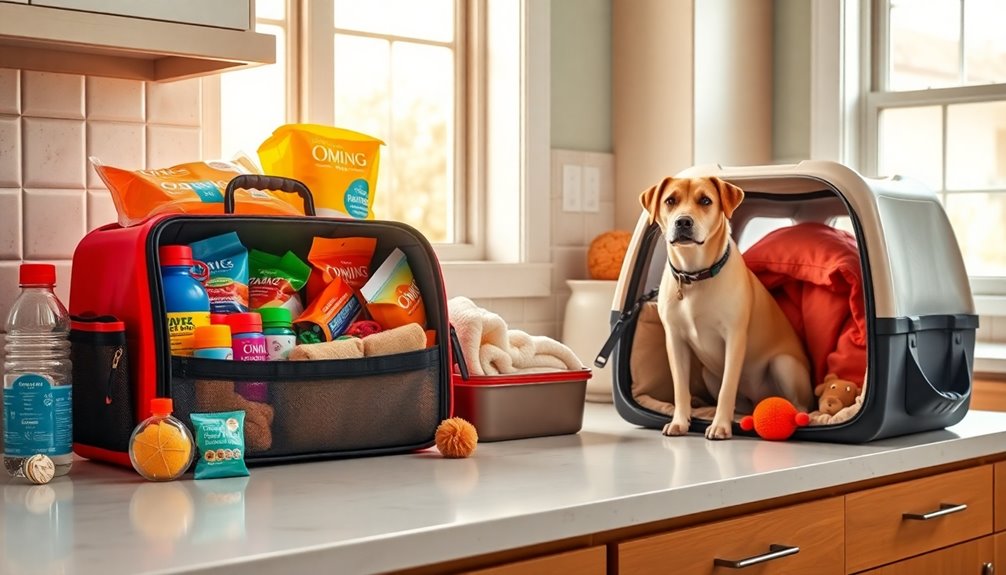To create a pet communication plan, start by gathering all essential contacts, including your vet, emergency clinics, trusted friends, and family members, and keep them easily accessible—both digitally and physically. Organize important documents like medical records, vaccination history, and recent photos so they can be quickly shared when needed. Make sure everyone involved understands the plan and knows where to find emergency info. Keep updating these details regularly to guarantee your pet’s safety in any situation.
Key Takeaways
- Compile and update emergency contacts, including caregivers, vets, and local animal services, in a visible, accessible location.
- Organize all pet medical records, vaccination history, and recent photos for quick identification and care.
- Distribute copies of the contact list and documents to all caretakers and store digital backups for convenience.
- Include special instructions for medications, allergies, and health needs within the pet’s medical documentation.
- Regularly review and update the communication plan to ensure accuracy and preparedness during emergencies.

Have you ever wondered how to better understand your pet’s needs and feelings? Creating a pet communication plan is an essential step in making sure your furry friend stays safe and well cared for, especially in emergencies. One of the most critical components of this plan is having up-to-date emergency contacts and veterinary info readily available. These details serve as your pet’s safety net, ensuring that anyone who might need to step in—whether a family member, friend, or pet sitter—knows exactly who to contact and where to get professional help.
Start by compiling a list of emergency contacts. This should include the primary caregiver’s contact information, trusted friends or family members who can step in if you’re unavailable, and your veterinarian’s phone number. It’s also wise to include local animal clinics, emergency animal hospitals, or 24-hour veterinary services. Keep this list in a visible, accessible place—like near your front door or in your pet’s emergency kit—and make sure everyone involved in your pet’s care has a copy. Clear, immediate access to these contacts can save precious time during a crisis, whether your pet is injured, becomes suddenly ill, or is lost.
Keep emergency contacts visible and accessible for quick help during pet crises.
Your veterinary info is equally crucial. This includes your veterinarian’s name, clinic address, phone number, and any special instructions related to your pet’s health—like medication schedules, allergies, or recent medical procedures. If your pet has a chronic condition or special needs, include detailed notes or documents that can be quickly shared with emergency personnel or new caretakers. Having this information at hand minimizes delays and ensures your pet receives the right treatment without unnecessary stress or confusion. Additionally, maintaining vetted products for your pet’s health and safety can help prevent issues and ensure quality care in emergencies.
Beyond just listing these contacts, consider organizing all relevant documents—vaccination records, recent medical history, and a current photo of your pet—in a dedicated file or digital folder. This way, if your pet goes missing or needs urgent care, anyone stepping in can access vital details instantly. Also, communicate these plans clearly with anyone who might care for your pet, whether it’s a pet sitter, neighbor, or family member. Make sure they know where to find emergency contacts and veterinary info, so they can act swiftly and confidently.
In short, creating a pet communication plan that emphasizes accessible emergency contacts and extensive veterinary info ensures that your pet is protected in every situation. It reduces panic, streamlines emergency responses, and provides peace of mind knowing that your pet’s needs are covered, no matter what happens. Being prepared with these details isn’t just smart—it’s a crucial part of responsible pet ownership.
Frequently Asked Questions
How Often Should I Update My Pet Communication Plan?
You should update your pet communication plan at least once a year, or after any significant change in your pet’s needs, contacts, or emergency procedures. Regular reviews help guarantee information stays current and relevant. If there’s a move, new vet, or change in your pet’s health, revise the plan promptly. Keeping your plan current gives you peace of mind and ensures everyone knows what to do in an emergency.
What Are the Best Apps for Emergency Pet Contacts?
You’d think in this digital age, finding pet emergency apps would be a breeze, right? Well, some of the best options include Pet First Aid, 24PetWatch, and Pet Emergency App. These apps help you build all-encompassing pet contact lists, ensuring quick access during emergencies. Download a few, keep them updated, and you’ll have peace of mind knowing help is just a tap away when seconds count.
How Do I Involve Children in the Communication Plan?
You involve children in the communication plan by encouraging child participation in emergency drills and discussions, making it engaging and educational. Family involvement is key, so you can assign simple roles or tasks that suit their age, like helping update contact info or practicing pet evacuation steps. This fosters responsibility and confidence, ensuring everyone knows what to do and feels included in protecting your pet during an emergency.
What Legal Documents Should I Include in the Plan?
You should include legal paperwork like your pet’s vaccination records, medical history, and any permits. Also, add emergency authorization forms that specify who can make medical decisions if you’re unavailable. These documents guarantee caregivers have all necessary info and legal permission to act in your pet’s best interest. Keep copies in a secure, accessible location and inform trusted contacts about their whereabouts for quick access during emergencies.
How Can I Ensure My Plan Is Accessible During an Emergency?
Don’t put all your eggs in one basket—ensure your plan stays accessible during emergencies. Store digital copies securely online or on a USB drive, and keep physical copies in a waterproof, easy-to-reach location like a fireproof safe or designated binder. Regularly update both formats to keep information current. This way, whether tech fails or chaos erupts, you’ll have your pet’s essential details ready at a moment’s notice.
Conclusion
By creating a pet communication plan, you’re planting seeds of reassurance and trust that will blossom in moments of uncertainty. Imagine your pet’s calm eyes meeting yours, knowing you’ve prepared to stay connected no matter what. With clear contacts and organized documents, you’re weaving a safety net of love and security. This plan isn’t just paper—it’s a promise to be there, guiding your furry friend through life’s storms with unwavering devotion.










